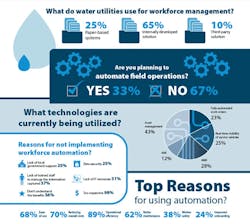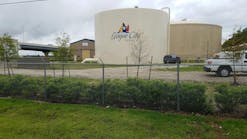Automating the Workforce - Changing Tides in the Water Utility Industry
By Carol Johnston
Water utilities have an important responsibility to keep customers’ water flowing. Understandably, utilities can be so focused on avoiding interruptions to service that they may miss out on new money-saving technologies, possibly doing a disservice to customers and themselves. Although the decision to not automate may appear to benefit water utilities financially in the short term, in the long term sticking with manual or partially-automated processes can hurt productivity and negatively affect the bottom line.
Water utilities considering implementation cite concerns about the initial financial output, the potential disruption to customers, and the time needed to fully train employees and contractors on new technologies. Although those factors can all dissuade a utility from making the switch to full automation, a utility that doesn’t fully automate is missing out on important benefits. The long-term savings and improvements in response times that come with automation not only improve the bottom line, they enhance customer perception - two vital markers of a utility’s success.
Homegrown Systems Can Be Deceptive
In its utility industry research, Clevest found that 25 percent of water utilities still use paper-based systems, including paper-based work orders and field management. Of those who have begun automation, the majority - 65 percent - have chosen to use an internally developed solution. Only 10 percent have chosen to go with a third-party automated solution, despite the ease of implementation and use.
Water utilities recognize that automation is necessary and homegrown automated workforce management is a step in the right direction, but such systems can be deceiving and typically have serious deficiencies. They are often built piece-meal and do not integrate well with other crucial back-office systems. At the same time, maintaining these pieced-together systems can overwhelm IT departments, who struggle to keep up with operating and maintaining them.
The lack of integration between systems means employees waste valuable time manually entering and re-entering data and reports into the various systems, costing the utility money and increasing the chances of serious errors. As field workers wait for data to be manually entered, work orders get backlogged and customers become impatient waiting for their utilities to be repaired. Unnecessary money is spent without ever increasing customer satisfaction.
In fact, when the operational efficiency of field work is not high, you often see the need for a worker to return to a work site to complete a job. When this impacts customers, it affects their satisfaction and experience.
Ultimately, the failure to fully automate will hurt a water utility’s productivity and profitability.
The Fears Don’t Match the Facts
All this begs the question: With so much on the line, why are water utilities not automating more quickly?
The answer lies in misunderstandings about technology and the perceived cost of automating. Water utilities operate under tight margins and budget constraints, and often view automating with a narrow perspective. The initial investment of automating seems daunting, so they never look deeper, to the massive savings they will incur as a result of more efficient workforce management.
While 98 percent of utilities who do not plan to automate list the perceived cost as a reason for not implementing workforce automation, there are a variety of other reasons given:
- Not understanding the benefits of automation (56 percent)
- Lack of trained staff to manage the information (37 percent)
- Lack of IT resources to manage the automated system (31 percent)
- Lack of local government support (25 percent)
- Concerns about data security (25 percent)
These concerns, alone or in combination, can keep water utilities from automating their field operations. In fact, the survey found that a staggering 67 percent of water utilities have no plans to fully automate their workforce management. What makes this especially surprising is that those that have fully automated, and have used a third-party solution, have found huge benefits to their finances and their customer perception.
Proven Profits
Take the case of the largest water utility in New Mexico, which reached out to Clevest after its work order backlog reached 3,000 and the utility determined it was losing millions of dollars because of systems that were not properly integrated. Thanks to paper-based work orders and manual meter reading, broken meters were being ignored, resources were improperly diverted, and field representatives drove unnecessarily high miles to complete a low number of work orders.
After implementing Clevest’s Mobile Workforce Management system, the water utility saw drastic improvements, including driving miles cut down by 50 percent, work order completions up by 100 percent, work order backlog slashed from 3,000 to less than 50, and customer satisfaction ratings improved substantially. This utility has saved millions of dollars per year when factoring in the reduced man hours, lowered gasoline bills, improved water meter maintenance, and decreased vehicle maintenance.
Other utilities have also seen improvements in their overall processes after automating their workforce management. Industry surveys and case study research have shown that mobile workforce management:
- Improves worker productivity by 62 percent
- Reduces overtime by 60 percent
- Improves on-time arrivals by 50 percent
- Cuts fuel consumption by 50 percent
- Increases customer satisfaction by 42 percent
- Decreases travel time by 15 percent
As for return on investment, many of these benefits are experienced as quickly as the first year of automating.
These benefits help create a really strong ROI on a mobile workforce management implementation at a water utility. The ease of use in terms of implementing a software system to automate your workforce where it comes out of the box with streamlined workflows - those unique digital forms - it can be simple but powerful in terms of capturing the key data, validating that data, and then sending it back in real time.
More Than Just Money on the Line
Additional benefits to automating include ease of use, operational efficiency from data entered and available in real time, streamlined maintenance, and decreased error risk.
Consider a utility in which workers receive paper schedules and printouts of the day’s worksites. Those field workers spend a good portion of their day determining which job site is next on their list, and how to get from one site to another.
Mobile workforce management systems offer dynamic rerouting, providing workers with immediate, comprehensive information about the next call and the best route to take to that call. They also enable utilities to be prepared in case of a severe situation, such as a storm or outage, which requires efficient responses and quick decision-making. Mobile workforce management decreases the time spent on paperwork and routing, and increases the time spent completing work orders.
Customers are happy because work is done quickly and appointments are kept on schedule, and utilities are happy because they move through the backlog of work orders more efficiently.
Appealing to Younger Workers
Customers are not the only ones that utilities must consider when they contemplate automating their systems. As the workforce ages, more companies are looking to younger people as the next generation of employees. However, these younger employees have grown up with high technological expectations. They want to work for companies that embrace technology, making data entry as simple and seamless as possible, and offer innovative user interfaces. Utilities who want to attract and retain younger employees must consider the value of technology in attracting an able workforce.
Now Is the Time to Invest
Whether your water utility faces increasing water prices, aging infrastructure, or a backlog of work orders, there is no better time to invest in mobile workforce management technology and begin enjoying the benefits of a fully automated workforce. With so much to gain from fully automating - including enhanced productivity, increased savings, and improved customer perception - the costs of implementing an automated system are far outweighed by the benefits.
About the Author: Carol Johnston is vice president of product marketing for Clevest and has over 15 years of product marketing and product management experience working in the mobile workforce management and other related technology industries. Prior to Clevest, she was vice president of product and strategic partnerships for Bazinga Technologies; solutions manager for ABB Software (formerly Ventyx); and product line manager for Itron, managing its product and go-to-market strategies.





